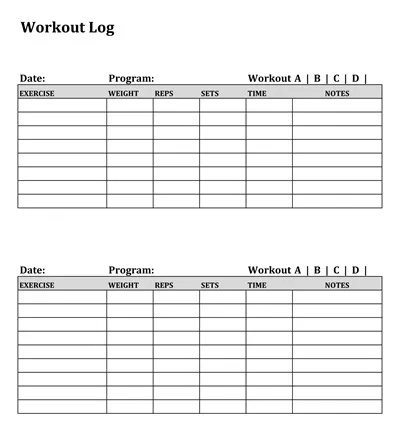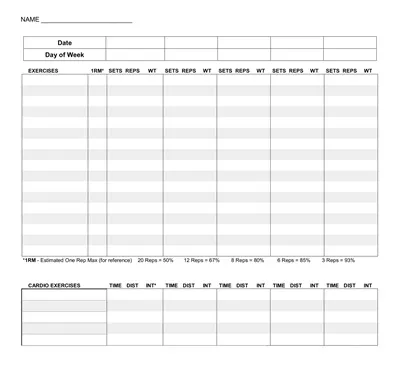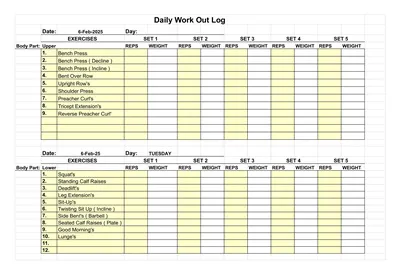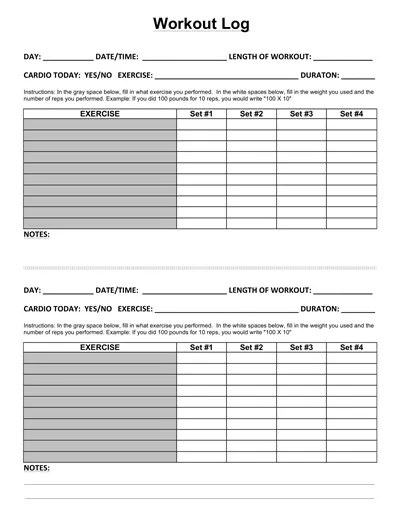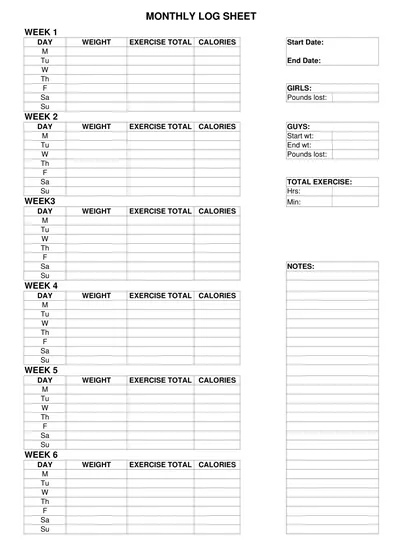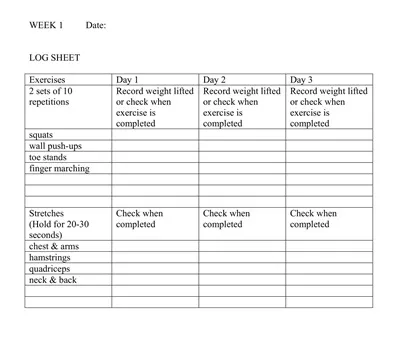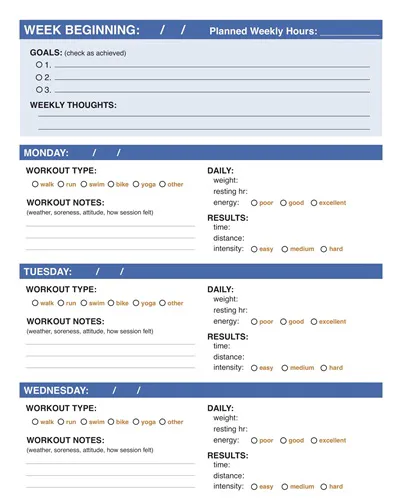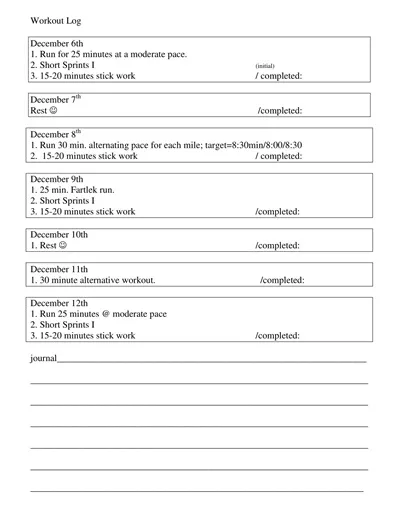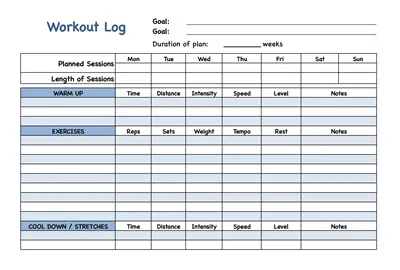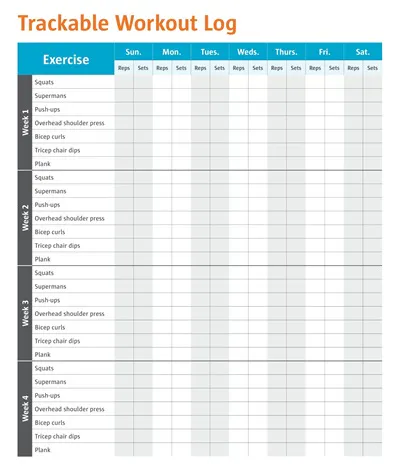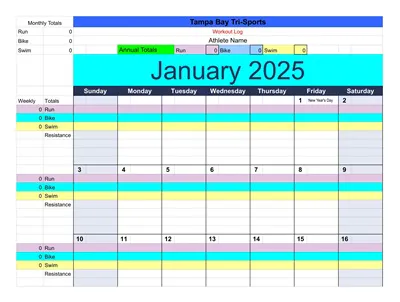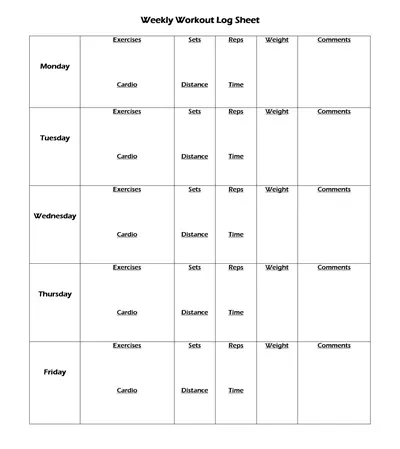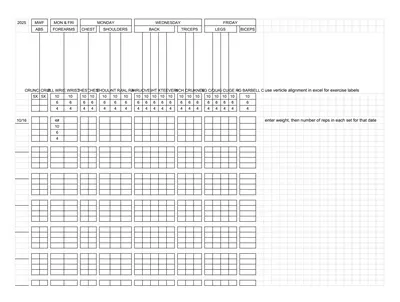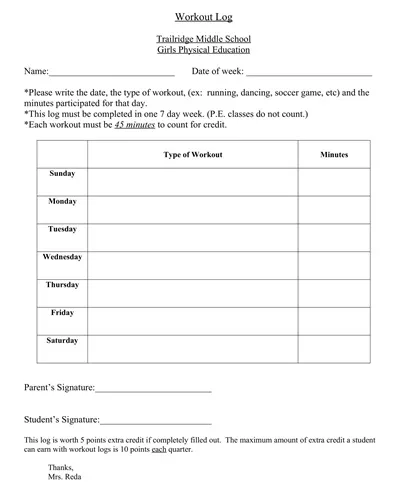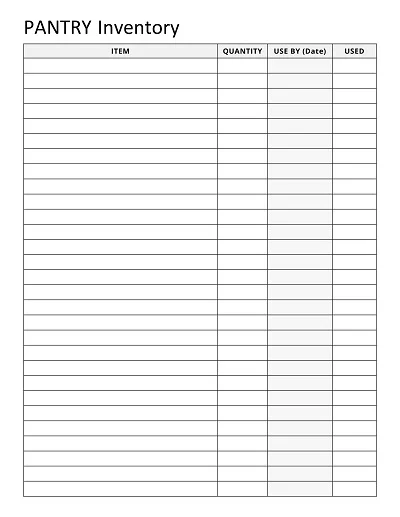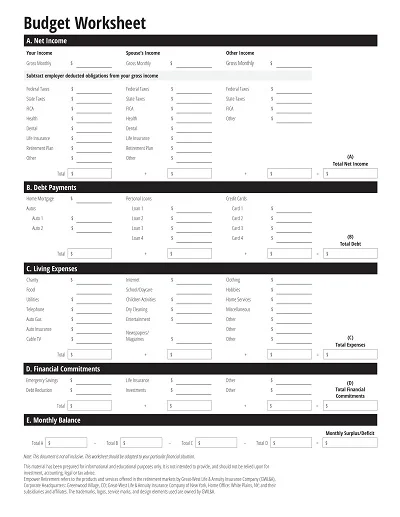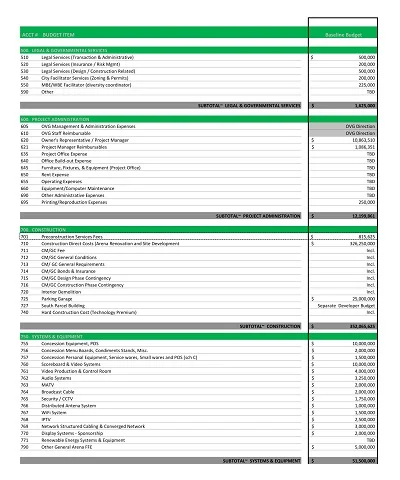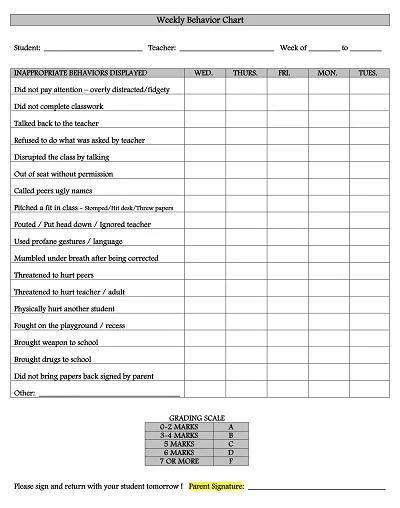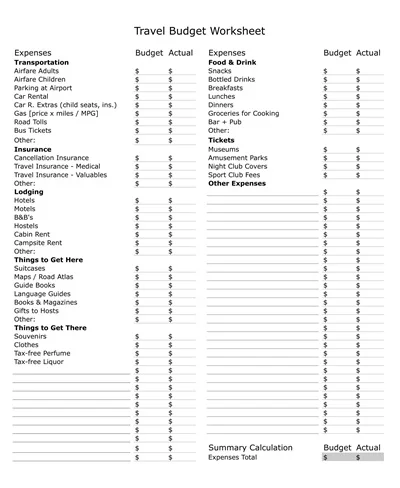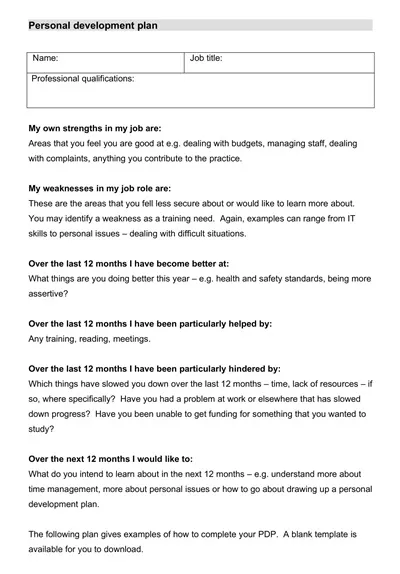A workout log template is an essential tool that assists people in monitoring and maximizing their fitness exercise sequences. The document provides users with an organized system to document their workout information, which lets them track their development while sustaining their exercise program.
A standard workout template contains scheduling information, including exercise dates, activity types, time lengths, repetition, weight data, and space to write performance assessment notes. Users tracking this data will discover patterns and set suitable goals while maintaining a balanced, effective training activity. The basic design of this tool enables all fitness levels to use it as a motivational tool for staying organized.
Download Free Printable Workout Log Templates
What is a Workout Log?
You can track your exercise session data using a workout log as a systematic recording instrument. The tool assists users in maintaining essential workout information, which includes the recorded exercises alongside repetition and set counts of weight usage and session time.
Committing to documenting fitness session data provides critical information that helps determine your fitness development status and enhances performance tracking and exercise plan modifications. The workout log functions as a practical tool in book form, application format, or pre-made template format to support your fitness goals while keeping you organized and focused.
Components of a Workout Log
Here are key parts that build an effective workout log to help users monitor and refine their fitness programs:
- The first necessary entry in a workout journal consists of the date and time you exercised. This information allows you to monitor exercise frequency to analyze your training schedule patterns easily.
- Exercise Specification Lists the particular workouts you performed as an essential part of recording your workout details. You should record any fitness activity you practice, including strength training, cardio, yoga, and other exercises that compose your routine.
- The record of workout duration enables you to monitor your advancement throughout time while ensuring continuous practice of your training.
- When conducting strength training exercises, you need to track the sets and the number of repetitions you perform for every exercise. The recorded data helps you determine your workout development and enables proper step-up of exercise difficulty.
- Note the weights you employ in each exercise when you utilize them—monitoring your performance progress with the help of this data during your training periods to maintain proper development.
- The notes section within workout log templates enables users to document extra details regarding their performance with space for improvement descriptions. The designated section provides a space to establish objectives for upcoming exercise sessions.
Types of Workout Log
Available workout logs serve multiple needs because each version matches specific fitness requirements. Several exercise-tracking methods exist with different characteristics, which follow:
1. Digital Workout Logs
A digital workout log application or computer program helps users manage workouts and automation functions. The electronic logs incorporate multiple capabilities, including alert systems and systems measuring performance development alongside integration for wearable fitness devices. Users who choose popular digital logs benefit from customizable routines that simultaneously display real-time performance data.
2. Paper-Based Logs
People like the traditional approach should use paper-based logs to record their workouts. People choose between basic notebooks and pre-made workout logbooks featuring different template designs. The logs combine portability with ease of customization and work without needing technology, making them perfect for users who seek simple solutions.
3. Spreadsheet Logs
People who excel at data organization should find spreadsheets as their preferred tool for data management. You can make custom tables and charts and establish formulas to track repetition counts, weight improvements, cardio times, and intensities. Individuals who need detailed organizational systems regularly choose spreadsheet logs for their preference in precise and structured recordkeeping.
4. Online Community-Based Logs
Workout logs connecting to social fitness communities give users the advantage of connecting with others with similar fitness aspirations. Sharing fitness progress lets users consult with others and strengthens their motivation through connections built within similar goal-focused fitness communities. The logs provide leaderboards along with group challenges that help users stay interested.
Selecting a workout log depends on your preferences, fitness goals, and lifestyle habits. Your fitness journey will find success through any type of log system, including technological convenience, pen-based reliability, or online community participation.
Benefits of Using a Workout Log
The many advantages of utilizing a workout log are that it will strengthen your fitness path. A workout log allows you to monitor continuous improvement, produce foreseeable progress, and keep you actively motivated. The same routine can be tracked easily by a workout log, leading to sustainable exercise habits because it operates as an organized record of your regimen.
A workout log helps you notice training patterns until you determine which exercises produce maximum outcomes and which training aspects need adjustments. Important data entries about sets of repetitions and weights will support your progressive training while minimizing plateau formation and protecting against training excesses. The workout log is your direction to maintain organizational focus toward specific fitness objectives.
How to Use a Workout Log
A workout log functions easily as you can customize it according to your fitness targets and personal preferences. Start using workout logs by following this approach.
- The first step is to choose from notebooks to use dedicated applications or printable templates. Select a system that works for you both practically and allows seamless regular use.
- Start every entry by noting your workout session’s exact date and time. Such logs enable you to monitor your workout commitment and specific schedule patterns.
- Write down your exercise list by specifying each workout, rep, and set amounts and weight details. Total accuracy in tracking progress requires specifying details carefully in your logs.
- Writers should maintain records about workout intensity together with rest interval lengths during each exercise session.
- Document key performance metrics regularly, encompass running distances and time spent on planks and weights you have lifted. The tracking system enables you to recognize your progress and change your objectives.
- Note down your physical and emotional reactions that occurred throughout your workout, together with post-workout feelings. Keeping track of your energy levels, discomfort factors, and positive achievements lets you gain motivation insights.
- The workout log should help you determine upcoming exercise sessions by designing a structured schedule that protects your muscles from fatigue while working in different groups.
Working with a workout log requires consistent use for maximum benefit. Updating the log alongside progress evaluation will transform it into an essential instrument to maintain focus while allowing you to reach your fitness targets.
Why Do You Need a Workout Log?
A workout log provides more than note-taking functions through its ability to help users achieve fitness organization alongside persistence and responsibility in their exercise routines. You can effectively monitor improvement trends through workout recording because it creates clear visual evidence of your advancement.
Your workout log enables you to discover patterns to understand which fitness exercises work best and what exercises you should modify to handle your physical plateau effectively. Your workout log protects you from overtraining, preventing you from hitting similar muscle areas without enough recovery time. A workout log enables better focus on your fitness goals by creating a structured framework to achieve those targets.
How to Create a Workout Log Template
A workout log template is straightforward and designed for personal fitness goal customization. Your logging efficiency will improve because a properly designed template directs your focus toward critical exercise factors.
The following guide outlines the steps to create a workout log template.
1. Choose Your Format
Consider your preference between physical notebooks and printable spreadsheets or digital fitness applications since manual writers like physical notebooks work well. Still, digital apps include built-in analysis and sharing features.
2. Include Basic Information
The first entry should include all essential workout details, including date and time, along with the specified location. Your planned entries will reveal possible patterns in your workout practices.
3. Plan Your Exercises
Include each planned exercise by writing down the number of sets, reps, and weight specifications. Aesthetic organization of your exercises based on particular muscle groups will help you find items easily.
4. Include Space for Notes
The sheet needs space to add workout-related notes between exercise sessions and post-workout assessment comments. You should note your energy status and discomfort levels with significant events while exercising.
5. Add Relevant Metrics
The log should include specific areas to track exercise metrics, including distance run, time spent on planks, and weight in lifting exercises. The tracking system enables you to monitor your performance development, which helps you reshape your objectives during the tracking period.
6. Plan Ahead
You should use your log to design forthcoming exercises to build an equal exercise structure while avoiding overtraining conditions. Keeping your tasks organized while staying motivated becomes easier using this log system.
7. Personalize Your Template
Add your adjustments to the template according to your requirements and targets. Exercising planning involves three modifications: workout preparation areas, post-workout stretching areas, and space for tracking meals and setting fitness goals.
You can build an essential fitness journal with these guidelines through your individual requirement specifications. Regular updates and reviews of your template will help you get the best results toward your goals.

